It's nice to have some fail-safe activities in your back pocket that can be applied to a variety of units. Here are five that have worked for me in the past. You can apply activities before and after the unit, and you might find that there are patterns and changes in their understandings. I have learned these activities at great professional development seminars and from colleagues.
For all activities, it is important to set clear ground rules before beginning.
For all activities, it is important to set clear ground rules before beginning.
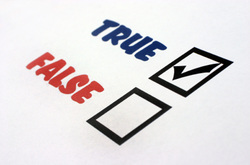
True/False Anticipation Guide
(Before and After)
Supplies:
Some of these lists already exist for novels or plays that you can find online (see example for Crucible from Mr. Jeffrey).
The page is set up in three columns:
(Before and After)
Supplies:
- Worksheet
Some of these lists already exist for novels or plays that you can find online (see example for Crucible from Mr. Jeffrey).
The page is set up in three columns:
| Before reading: (Choose one) X True / False | Thematic question relating to the coming unit Money can buy happiness | After reading: (Choose one) True / X False |
You can lead a discussion about their responses before and after the activity. The worksheet leads nicely to a charting activity (graph of some sort) afterwards. Tip: You might want to collect the worksheets and return to students at the end of the unit if students are likely to lose their work.
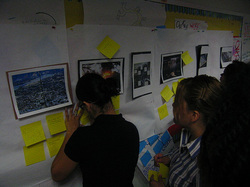
Gallery Walks
(Before and After)
Supplies:
Tip: limit the number of stations to 6, ideally keep groups per station below 5 students.
Great resources available at the Starting Point website.
Photo: http://www.flickriver.com/photos/kenstein/55391651/
(Before and After)
Supplies:
- Butcher paper with pre-written headings
- Writing utensils/markers
- Optional post-its
- Post butcher paper to represent stations around the room.
- Each paper should be prepared with titles describing themes or big ideas relating to the unit.
- Students can either use post-its or write directly on the butcher paper, but post-its allow for re-use in following classes.
- Group students evenly and have them rotate from station to station, and they should anonymously write free associations (ideas, examples, opinions, symbols) that relate to the title on the butcher paper.
- You can limit student responses to how many post-its you provide them.
- An optional second round can ask students to 'star' or 'agree' with other student responses.
- After rotating all of the stations, the teacher reads out a summary of answers and records them (photograph, assign a student scribe) to review again after the unit.
Tip: limit the number of stations to 6, ideally keep groups per station below 5 students.
Great resources available at the Starting Point website.
Photo: http://www.flickriver.com/photos/kenstein/55391651/
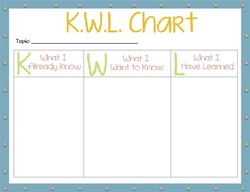
KWL Chart
(Before and After)
Supplies:
To add another layer, you can have students use post-its and then transfer 'what they know' and 'want to know' to a class-wide version of the chart.
Image: http://tweenteaching.blogspot.co.il/2012/08/kwl-chart.html
(Before and After)
Supplies:
- Worksheet
- The picture to the left provides a simple explanation.
- The first two columns of the chart (K - what I already know, and W - what I want to know) are to be filled in before diving into the unit.
- The last column can be preparation for final assessments.
To add another layer, you can have students use post-its and then transfer 'what they know' and 'want to know' to a class-wide version of the chart.
Image: http://tweenteaching.blogspot.co.il/2012/08/kwl-chart.html
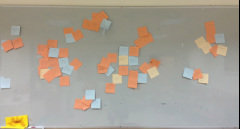
Idea Storm
(Before and After)
Supplies:
I have used this activity more broadly, as in "What are your personal goals for this year, for this class, etc?"
*At the end of the year, run the same activity and discuss changes in answers, whether goals were met, etc.
(Before and After)
Supplies:
- Post-it notes
- Optional white board or Butcher paper to collect post-it notes
I have used this activity more broadly, as in "What are your personal goals for this year, for this class, etc?"
- Students receive 3-5 post-it notes or non-stick notes to anonymously answer the question in a variety ways.
- (Optional: notes are turned in and the teacher shuffles the papers and re-distributes to other students. Students read one response aloud and the class suggests general themes that appear in responses.)
- Students place post-its or tape up notes to the board or butcher paper relating to other notes.
- The teacher reads aloud notes and with the classes help, reorganizes as needed.
- Record/photograph answers as reference for the end of the year. Students can record their own answers and track their own progress throughout the year in teacher-student conferences.
*At the end of the year, run the same activity and discuss changes in answers, whether goals were met, etc.
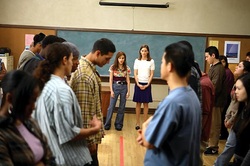
Philosophical Chairs
(Best for after reading)
Supplies:
I learned about this activity at an amazing professional development with AVID (Advancement Via Individual Determination).
A helpful resource by Andara Macdonald, Ph.D.
Photo from: Freedom Writers movie
(Best for after reading)
Supplies:
- List of themes prepared, give to students before the activity to plan ideas and examples
- Optional: Signs labeled "Yes" and "No" hanging on sides of the room
- Optional: Butcher paper or whiteboard to record student arguments (or computer with projector, etc.)
- Provide a reading assignment (articles, short stories, poetry, video, etc -- all relating to similar themes)
- One side of the room is labeled "yes" and the opposite side to "no"
- The teacher asks the class thematic questions. Example questions: Are there universal ideas of good and bad? Can jail rehabilitate people?
- Students move to 'yes,' or 'no,' sides of the room
- Students from yes and trade off arguing their cases based on supportive examples (personal, movies, literature, etc).
- Regulate 'yes' must wait for 'no' to respond before 'yes' can speak again. It could be a good idea to set the rule in advance that students must wait for two students to speak before they can speak again.
- Students may switch sides of the room after a convincing argument.
- The teacher should make a chart on butcher paper or on the board as students answer to provide visual aid.
I learned about this activity at an amazing professional development with AVID (Advancement Via Individual Determination).
A helpful resource by Andara Macdonald, Ph.D.
Photo from: Freedom Writers movie
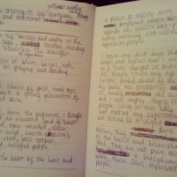
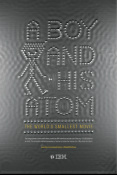
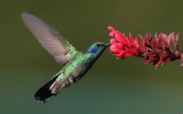
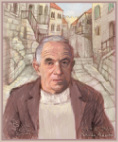
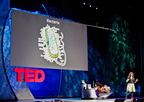

 RSS Feed
RSS Feed